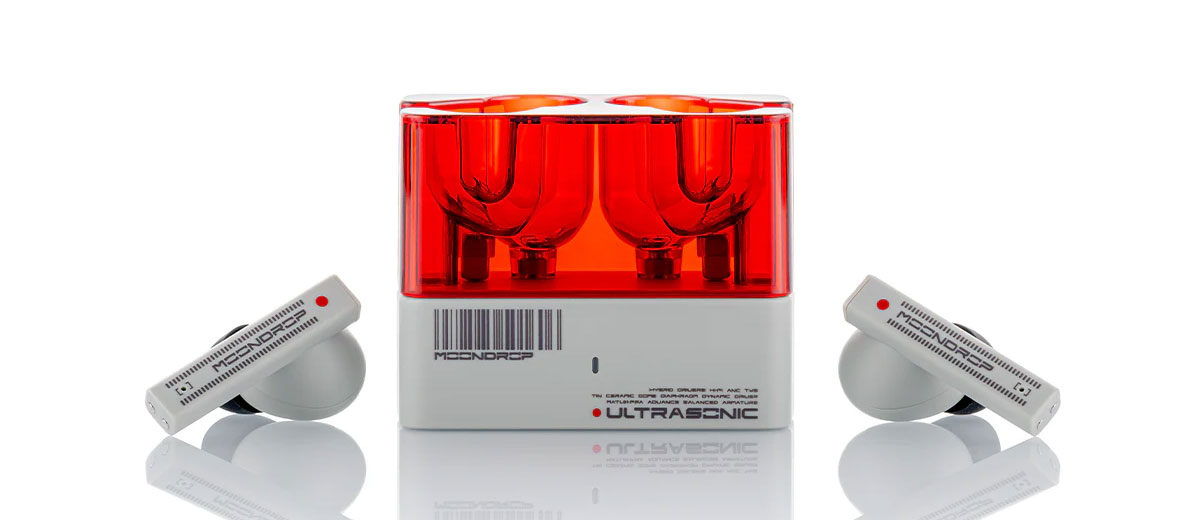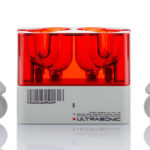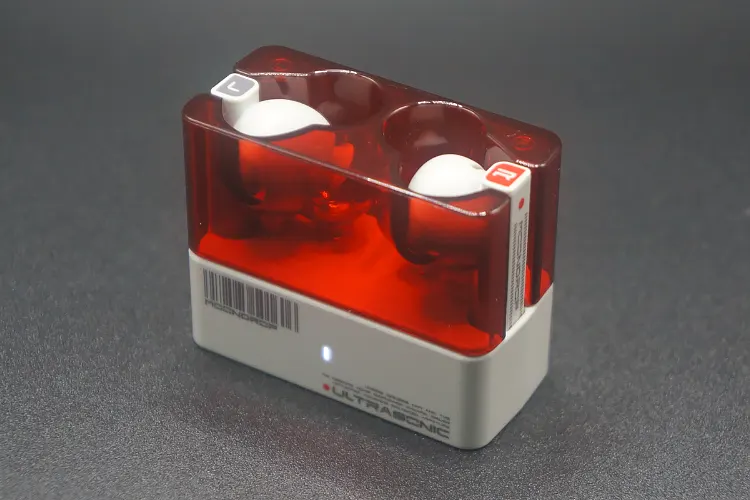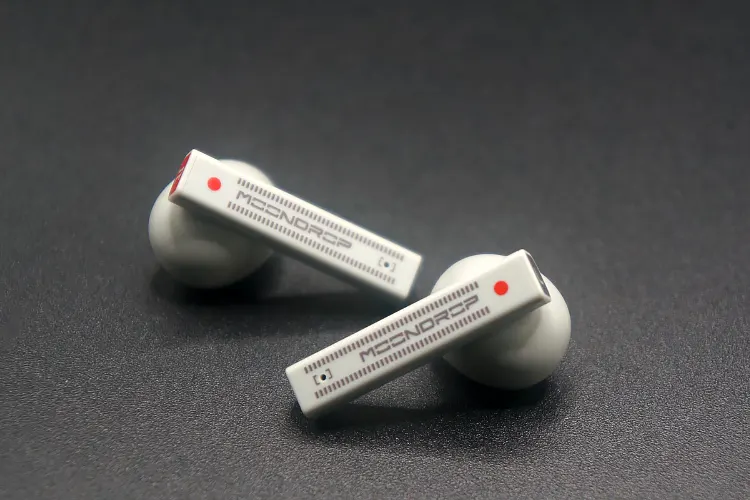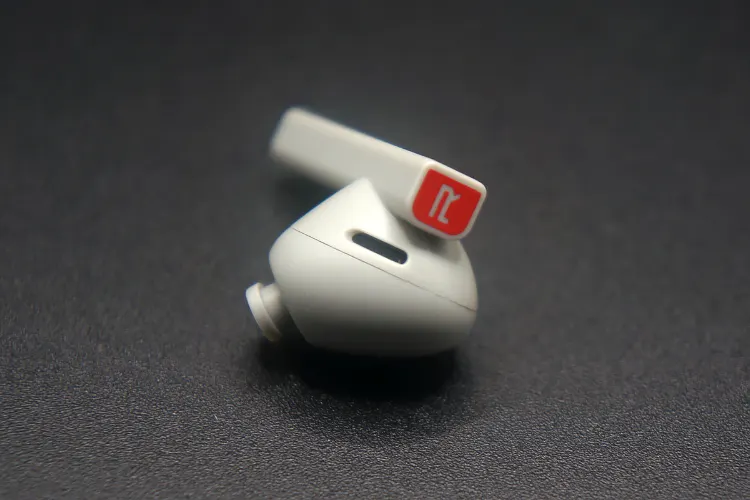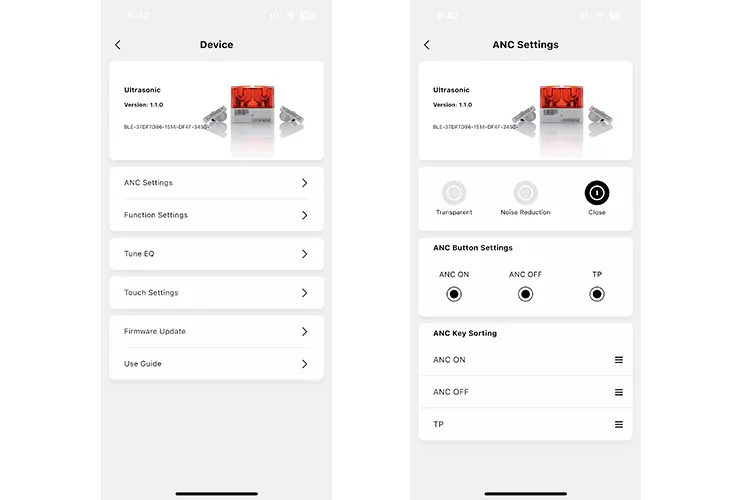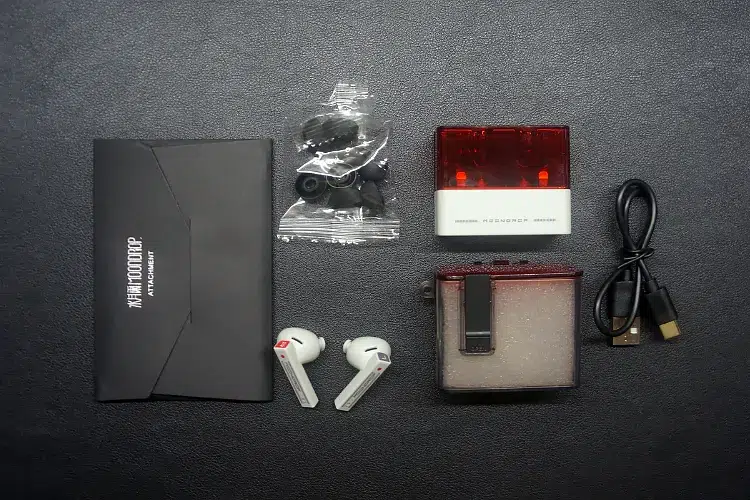Today, Meldrick reviews the MOONDROP ULTRASONIC, a hybrid dynamic and BA driver TWS equipped with BT5.3, LDAC decoding, and ANC. It is priced at $74.99.
Disclaimer: This sample was sent to me in exchange for my honest opinion. Headfonics is an independent website with no affiliate links or status. I thank MOONDROP and Shenzhen Audio for their support.
Click here to read more about MOONDROP products we have previously reviewed on Headfonics.
This article follows our current scoring guidelines which you can read here in more detail.
By now most audiophiles know MOONDROP for their iconic wired IEMs such as the Blessing 3 and Variations, however, they’ve also been a consistent competitor in the True Wireless IEMs space, with releases such as the Alice and Golden Ages.
Their newest entry, the ULTRASONIC, stands out from the rest by being the first MOONDROP hybrid dynamic driver and BA pair of wireless earbuds (TWS).
Slotting in the middle of MOONDROP’s TWS lineup at $74.99, it is only $5 cheaper than the planar magnetic Golden Ages. Its unique driver may make it an interesting prospect not only within MOONDROP’s TWS lineup but in the sub-$100 TWS market as a whole.
Read through my review below to see how the ULTRASONIC Performs and compares against other TWS IEMs in the market.
Features
Unlike most of MOONDROP’s TWS IEMs, the ULTRASONIC comes with a 13mm Sapphire Diaphragm driver alongside an all-new FRA Direct Radiation BA driver.
According to MOONDROP, this BA driver is able to deliver a wider range of high-frequency tones by reducing standing waves and by using a lighter lithium-magnesium alloy.
With LDAC, AAC, and LC3 codec support out of the box, the ULTRASONIC offers a robust array of codecs suitable to receive from a wide range of sources
The ULTRASONIC also comes with Active Noise Cancellation (ANC) and Transparency Mode with audio pass-through. These features add to its versatility, allowing users to either block out distracting background noise or stay aware of external sounds during walks or jogs.
Design
Cradle
Listeners familiar with MOONDROP’s Space Travel IEMs already know what to expect from the ULTRASONIC since both IEMs share the same cradle design. The base of the cradle is constructed out of a grey, soft-touch plastic with a matte texture that is smooth to the touch.
The upper half of the cradle is made from a thin translucent resin-like plastic with a reddish tint. The top portion has a pair of hollowed-out chambers in the shape of the ULTRASONIC earbuds, letting them sit snuggly in place once they stick to the cradle’s magnetic pins.
The top of the shell is empty, leaving the upper portion of the earbuds completely exposed even while they’re in the case. Despite the cradle’s strong magnets, the earbuds still fall out when shaking the ULTRASONIC upside down.
In regular day-to-day use, it’s unlikely that repeated upside-down shaking motions will occur, but it’s important to point out that the ULTRASONIC’s earpieces are not held as securely as most TWS offerings.
However, the included rubber case comes with a plastic lid, acting as the Cradle’s top cover. Because of this, I cannot recommend using the ULTRASONIC without the included case.
The case has a nice rubbery texture that provides a decent degree of protections during drops and falls; however, the translucent grey material is quite prone to showing scratches stemming from daily use.
Earbuds
Just like its cradle, the ULTRASONIC’s earbuds share design with another pair of TWS IEMs in MOONDROP’s line-up.
This time, it shares the Golden Ages earbud design. The shape and layout of their earbuds are completely identical, in fact, I was able to place the ULTRASONIC earbuds in the Golden Ages and vice-versa.
The earbud stems have a rectangular shape that makes them easy to pull in and out of the ear and do not cause any comfort issues.
However, the earbuds are constructed out of the same soft, matte-finish plastic as the cradle’s base.
The earbuds did a good job of hiding oils, fingerprints and dead skin. Even after weeks of use, the earbuds themselves still look new, which is something I can’t say about the other TWS IEMs I’ve tested.
The stems have a stylized MOONDROP logo surrounded by an abstract array of lines, with a red dot at the top of the front surface. The top of the earbuds continues the same grey and red motif, with the top of the right earbud being colored red, and the left being colored grey.
The earbuds have a subdued aesthetic, especially compared to the Golden Ages they borrowed from, making the ULTRASONIC an easier fit in most people’s everyday carries.
Controls
The MOONDROP ULTRASONIC’s control scheme is quite similar to most TWS sets in the market, and practically identical to MOONDROP’s other offerings.
A single tap on either side serves as play/pause, a double tap on the left side skips to the previous track, and a double tap on the right-side skips to the next track.
Triple taps activate the voice assistant and pressing and holding for 3 seconds cycles between ANC, Transparency mode, and Standard mode where neither ANC nor Transparency mode are turned on.
The ULTRASONIC still comes with MOONDROP’s clever active mode indicator system. When switching to ANC mode, a soft anime-style female voice gently whispers “Shhh,” signaling that noise cancellation is enabled.
Switching to standard mode triggers an “Ummm…” sound, while a playful “Hey!” marks the transition to Transparency mode.
The default control scheme of the ULTRASONIC felt intuitive and easy to use. However, for those who prefer a different setup, the MOONDROP Link App offers a straightforward way to customize the controls to suit individual preferences.
Comfort & Isolation
Since the ULTRASONIC shares the Golden Age’s earbud design, it unfortunately also shares its finnicky comfort and isolation performance.
The ULTRASONIC’s plastic earbuds are still decently comfortable once a seal is formed, however since the nozzle and ear tip are both oval-shaped, each earpiece must be rotated to a specific orientation to form an effective seal.
In comparison, TWS or IEMs with circular nozzles are much simpler to seal, as their round nozzles and tips maintain consistent dimensions regardless of orientation.
During my testing of the ULTRASONIC, I frequently had to readjust the earbuds after inserting them to find the correct positioning.
The need for constant readjustment was particularly frustrating due to the earbuds’ touch controls. When trying to reposition them, I instinctively grabbed the stems, inadvertently triggering Pausing my music or skipping to the next track.
That said, once a proper seal is established, the ULTRASONIC delivers impressive passive isolation.
Even in standard mode with ANC off, it effectively blocks out road noise and quieter conversations. With ANC activated, it completely blocks out background noise and surrounding conversations.
Cradle & Battery life
During my testing, the ULTRASONIC’s battery life closely matched MOONDROP’s advertised 6-hour runtime. With mixed usage of ANC and Transparency modes, I typically achieved around 5.5 hours of playtime per charge.
When the earbuds ran out of power, placing them in the charging cradle restored a full charge in approximately an hour, consistent with MOONDROP’s claims.
The cradle itself provided about three additional full charges, bringing the total battery life to roughly 17 to 18 hours of mixed usage.
The cradle uses a subtle LED on the front of the unit to display helpful battery information. When the cradle is charging the earbuds, it will shine a solid white color. Once the earbuds are fully charged, the light will turn off.
The LED also acts as a cradle charging indicator, wherein it shines orange while the unit is being charged, then turn off when the cradle is fully charged.
However, the cradle has one glaring omission, a pairing button. Unlike the Golden Ages and other TWS IEMs, I would simply hold the pairing button to force the earbuds to disconnect from one of my devices (i.e. Smartphone) and pair it to another device (i.e. laptop).
The only way to unpair the ULTRASONIC is by having it paired to a device, and simultaneously holding both right and left earbuds for 3 seconds.
Not only is it significantly more inconvenient, but I also found that holding both earbuds still forces the ULTRASONIC to cycle through ANC and Transparency mode before disconnecting.
Because of this, I found myself just disconnecting the ULTRASONIC directly from my source devices. This was somewhat of a deal breaker for me, leading me to gravitate back to the Golden Ages.
Software App
The ULTRASONIC’s companion app is the revamped MOONDROP Link 2.0. Thankfully, the app has now been published on the iOS App Store and Google Play Store.
During my previous review of the Golden Ages, the Link 2.0 app was completely unavailable on the iOS App store, forcing me to sideload it on an Android device. This is a welcome development, since it fully unlocks the IEM’s functionality to all smartphone users.
The app’s UI has undergone a redesign since the last time I used it. Now, selecting the ULTRASONIC on the device menu opens a menu with settings to control ANC, Function (Gain Control), EQ, Touch Controls, OTA Firmware Updates, and a digital copy of the instruction manual.
The app’s ANC tab lets users customize the cycling order of the listening modes, though I found the default Standard-ANC-Standard-Transparency sequence to be perfectly adequate.
In the touch control section, users can reassign the default earbud functions to various touch and hold combinations. However, I found the default controls intuitive and well-suited to everyday use.
Packaging & Accessories
The unboxing experience of the ULTRASONIC is still quite good, with the box’s top cover having an exposed plastic window to show off the ULTRASONIC’s cradle and earbuds. However, it pales in comparison to MOONDROP’s other products such as the Blessing 3 and Golden Ages.
Opening up the box shows a black plastic tray holding the earbuds, carriage, TPU case, charging cable, and 3 additional pairs of ear tips excluding the ones mounted on the earbuds.
Sound Impressions
EQ Profiles
As of firmware version 1.1.0, the ULTRASONIC and the MOONDROP Link 2.0 app comes with five EQ profiles: Club, Monitor, Reference, 89XX and 336XX.
The Club, Monitor and Reference profiles are quite similar, with the primary difference being the bass level. The monitor profile has the least bass, the Club profile has the most bass, and the reference profile lies in between.
According to MOONDROP, the 89XX tuning profile is meant tuned “according to a flagship Hi-Fi earphone” while the 336x is tuned “according to a super flagship Hi-Fi earphone”.
While I do not know the IEMs MOONDROP patterned for these profiles, I found them to be significantly less enjoyable than the first 3 profiles.
The 89XX profile gave the ULTRASONIC a more V shaped sound signature, giving the sub and mid-bass a significant boost. This gave the IEMs a more fun sound signature, but I found that it gave vocals a slightly muffled tonality.
In my testing I also found that the 89XX tuning had a lower volume level compared to the first three profiles, forcing me to increase my volume by an additional 2 steps.
The 36XX profile was borderline unlistenable, sucking out all the life from the midrange and making vocals and string instruments sound like they were coming from a tin can.
Depending on the track, I found either the Reference or Club profiles to be my preferred EQ Settings. For the following comparisons, I will be using the Club profile unless otherwise stated.
Bass
Even on its Club setting, the ULTRASONIC has a fairly neutral sound presentation aside from a deep hitting sub bass. The sub-bass never overpowers the mid-range or comes off boom, it just has a depth and texture level that beats out other TWS IEM’s I’ve tried.
This focus on sub-bass quality over quantity gives hits from kick drums a tactile feel that doesn’t sound bloated or un-natural. However, for my preferences, I found the sub-bass quantity a bit lacking, even on its club setting.
Unfortunately, deep synths and bass guitars in the mid-bass region come across as thin, missing the rich, velvety warmth that often enhances funk and RnB tracks.
This absence of low-end depth results in a lean sound signature, which, on the plus side, ensures that the bass doesn’t bleed into the mids.
Bass enthusiasts seeking the ULTRASONIC for bass-heavy tracks might find it underwhelming. Even with the Club profile enabled, the ULTRASONIC delivers a low end that reaches deep but lacks significant impact.
That said, this restrained bass contributes to a cleaner, more focused midrange, aligning with its lean sound signature.
Mids
The ULTRASONIC has an inoffensive mid-range that does not excel in delivering class-leading detail or flagship-levels of tuning, however it is decent enough at all these traits to be a serviceable jack of all trades within the price range.
Even on the more bass-forward club profile, both male and female vocals are presented in a clean manner. Male vocals lack the depth and warmth that I am accustomed to from warmer IEMs, but vocal performances still come through with decent emotion and detail.
Female vocals have a bit more energy, especially towards the high end, but they still do not have the same detail level as the planar magnetic Golden Ages.
String instruments and keys take a back seat compared to the vocals. Individual strums feel one-dimensional, with the ULTRASONIC struggling to playback the harmonics needed to articulate the minute differences between plucks and strums.
With a neutral mid-range presentation, the ULTRASONIC’s midrange performance doesn’t necessarily miss the mark, but it does not have the detail retrieval, instrument separation or tuning that captures the listeners attention.
Treble
Just like its midrange, the ULTRASONIC’s treble is inoffensive, never coming of as sibilant or peaky. However, it also struggles to deliver a convincing sense of energy or detail throughout the entire treble region.
Hi hat hits and cymbal strike get the job done on the ULTRASONIC, being able to present them in a way that cuts through the mix. However, they are presented with only decent detail retrieval, and lacking and micro detail that makes each strike easily distinguishable from each other.
Listeners looking for more edge or aggression in their music may feel underwhelmed with the ULTRASONIC. However, it doesn’t have any obvious faults that could be considered as a deal breaker.
Staging & Dynamics
The ULTRASONIC’s imaging and instrument separation are only decent for a set of TWS IEMs, possibly as a result of only decent detail retrieval, the ULTRASONIC doesn’t have the pinpoint positioning I experienced on the Golden Ages.
Poorly mastered tracks with multiple layers can come off as a solid wall of sound through the ULTRASONIC. It never comes off as bloated or sibilant, the individual instruments just have a hard time distinguishing themselves from each other within a space.
The ULTRASONIC offer a respectably wide soundstage. While it doesn’t reach the fully immersive 360-degree soundscape of larger, airier IEMs or headphones, it still provides an engaging sense of space. This makes for an enjoyable listening experience, particularly with more intricate musical arrangements.
Click on page 2 below for my wireless performance assessment and selected comparisons.

